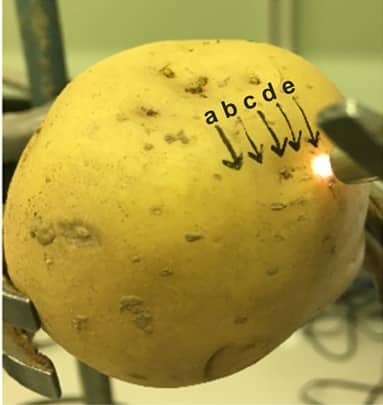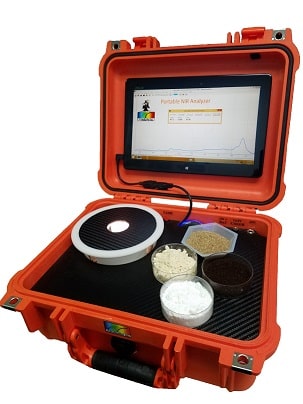
1. Are your Potatoes ready to be the main dish?
In order to have enough potatoes for every version of your Aunt Helen’s Mashed Potatoes, or to satisfy the appetite of Uncle Larry, a substantial proportion of potato crops are stored under controlled conditions to provide a year-round supply. Quality is measured by regular inspections, but automated processes are highly desirable for making post-harvest measurements in industrial environments. The production of chlorophyll in the stored potatoes is of concern with regard to food safety because increased levels and toxic glycoalkaloids are stimulated by light.
At the Teagasc Food Research Centre in Ireland, along with two UK researchers, they’ve found that they can use differential kinetics to monitor the state of stored potatoes using a Vis-NIR spectrometer system. The aim of their work is to provide a tool for better crop management, and thereby ensuring enough good, and not toxic, potatoes for all of Aunt Helen’s Mashed potatoes.
Vis-NIR reflectance spectra of potato tubers’ skin surface were recorded using an BLUE-Wave NIR-200 spectrometer equipped with a VIS-NIR silica fiber optic reflectance probe and SL1 Vis-NIR Tungsten Halogen light source.
Learn More: Published in “Postharvest Biology and Technology”
Using induced chlorophyll production to monitor the physiological state of stored potatoes (Solanum tuberosum L.)
Researchers: Jessica M.R.Garnett, Nikolaus, Wellner, Andrew G. Mayes, Gerard Downey, E. KateKemsley
2. Making sure your Turkey is delicious and safe to eat
The Turkey that you serve your guests on Thanksgiving should be tender, flavorful, and help put your guests in a food induced coma. If anyone gets sick after the meal, blame Aunt Helen’s Potatoes, because your Turkey is being made safer. Canadian researchers are using novel antimicrobial technologies, such as Atmospheric Cold Plasma (ACP) in synergy with Peracetic Acid to reduce the amount of Salmonella on raw meat.

In the US, foodborne Salmonella bacteria causes about 1.2 million illnesses, 23,000 hospitalizations, and 450 deaths every year (U.S.CDC). In Canada, there are over 88,000 cases of Salmonella-related foodborne illness accounts each year. This University of Alberta team is looking to reduce that number, and is using the BLACK-Comet spectrometer to aid in their work. According to their paper in the Journal of Food Protection, the researchers, “The optical emission was captured with a BLACK-Comet and was evaluated using SpectraWiz software (StellarNet).” The conclusions from this study demonstrate “the synergistic effect of ACP and PAA and its potential application for the safety of poultry products.”
Learn More: Published in “Journal of Food Protection”
Atmospheric Cold Plasma and Peracetic Acid–Based Hurdle Intervention To Reduce Salmonella on Raw Poultry Meat
Researchers: SHREYAK CHAPLOT, BARUN YADAV, BYEONGHWA JEON, and M. S. ROOPESH

3. And for dessert, Mite-free strawberries or Apple Pie?!
And we would never forget dessert! Sumptuous strawberries or tart apples – yum. We’re even contributing to research to keep those strawberries “mite-free” and assess the health of an apple orchard. In West Virginia, at the Appalachian Fruit Research Station, lower-cost methods are being developed to determine the Normalized Difference Vegetation Index (NDVI) of citrus and apple trees. NDVI can be taken via remote sensing and calculated to assess green biomass in addition to nutrient, pest, and water stress – basically the remote sensing of plant health in the field. To calculate NDVI, these techniques utilize combined near-infrared (NIR) and visible detection by low cost web cameras in comparison with a dedicated NDVI sensor and direct measurement of red-green-blue (RGB) and NIR bands.
Learn More: Published in “International Journal of Fruit Science”
Evaluation of Five Methods to Measure Normalized Difference Vegetation Index (NDVI) in Apple and Citrus
Researchers: David Micheal Glenn and Amy Tabb
In order to keep your strawberries plump and juicy, farmers often need to control the two-spotted spider mite, a worldwide pest of many agricultural crops. Instead of chemical pesticides, researchers are using UV-C irradiation, just a 60-second treatment at night. The irradiation was measured with a StellarNet calibrated spectrometer during testing. These results are being combined with autonomous robots that could treat greenhouses or fields with UV-C light.
Learn More: Published in “Pest Management Science”
UV-C irradiation as a management tool for Tetranychus urticae on strawberries.
Researchers: Brent D. Short, Wojciech Janisiewicz, Fumiomi Takeda, and Tracy C. Leskey
The StellarNet Debate! I yam what I say I yam.
Yet… do you really know what a yam is? Candied yams, sweet potato pie, the orange vegetables are (usually) a welcome dish at any Thanksgiving or Friendsgiving meal. But is there a difference between yams and sweet potatoes?

There IS a difference between sweet potatoes and yams. When you buy a can of yams you are actually buying a can of sweet potatoes (usually with a syrup for extra sweetness). When you are walking through the tuber aisle of your grocery store you’ll see sweet potatoes next to yams.
 Here at StellarNet, to get a TRUE yam we had to search far and wide. True yams are native to Asia and Africa. According to the Kitchn, “Yams have a cyclindrical shape with blackish or brown, bark-like skin and white, purple or reddish flesh.” Yams are drier and starchier than sweet potatoes. If you look closely, you can see Kimberly is holding an actual Yam!
Here at StellarNet, to get a TRUE yam we had to search far and wide. True yams are native to Asia and Africa. According to the Kitchn, “Yams have a cyclindrical shape with blackish or brown, bark-like skin and white, purple or reddish flesh.” Yams are drier and starchier than sweet potatoes. If you look closely, you can see Kimberly is holding an actual Yam!
So what’s with the yam that you buy at your local grocery store? There are two main types of sweet potatoes – firm and soft. Originally firm sweet potatoes were produced in the United States. When the soft variety began to be produced – grocers needed a way to make sure shoppers knew the difference. Soft sweet potatoes resemble the traditional yam and thus the (not) yam was born.
Our StellarNet Thanksgiving Experiment
Here at StellarNet we like to play with our food. So, we got a true yam, a sweet potato, and several pies and got to “work”. Using a DWARF-Star NIR spectrometer, reflectance probe, and SL1 Tungsten Halogen light source we measured the reflectance spectrum of a Yam, Sweet Potato, regular Potato, sweet potato pie, and pumpkin pie. Each sample shows it’s unique reflected light spectrum which can be used to identify the sample type and even analyze its compositional sugars and starches. Using chemometrics we can easily create calibration models different food samples in order to predict composition.
Analyzers for Industry
At StellarNet, our application product division, “Analyzers for Industry” is releasing a series of new, ready-made systems for quick analysis of agricultural products and food and beverages using near infrared technology. From composition analysis to process optimization and quality control, the StellarCASE-NIR will allow you to determine multiple parameters simultaneously. Incoming raw materials are easily measured to verify they meet all specifications certified by the vendor and batch ratios can be monitored for uniformity, ensuring a quality final product, avoid over-processing, and much more. With field portable, rugged design and rapid results, the StellarCASE-NIR is delivered with “Starter Calibration Packages” for the following Food & Beverage categories: Small Grain, Coarse Grain, Oilseed, Beans, Meat, Dairy, & Produce
We wish everyone a Happy Thanksgiving holiday season. Feel free to drop us a line at ContactUs@StellarNet.us and see your idea become our next fun App note.
















